The European Badger
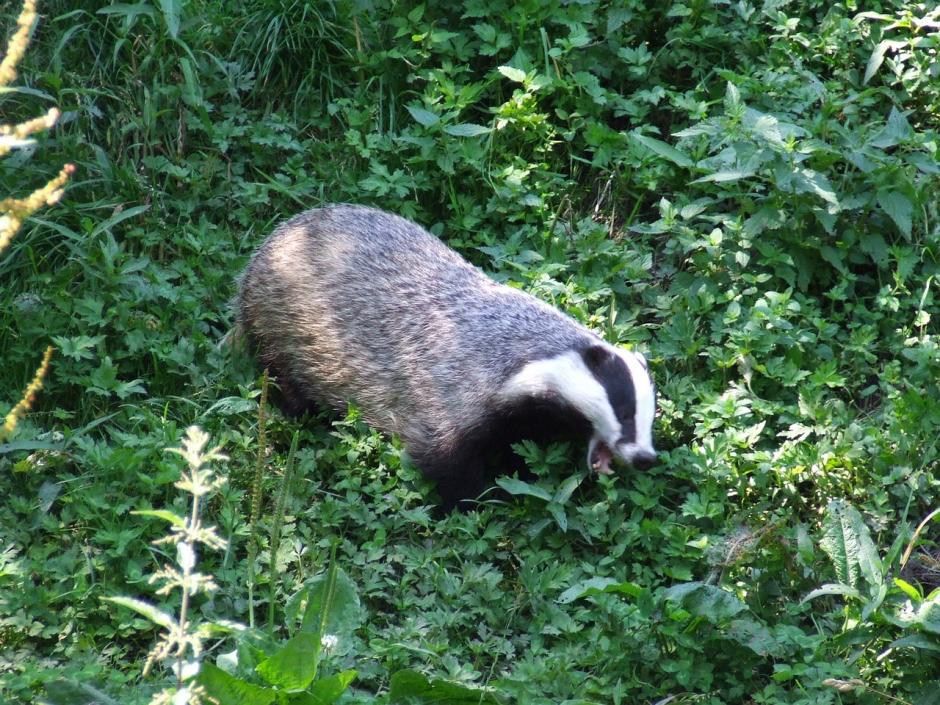
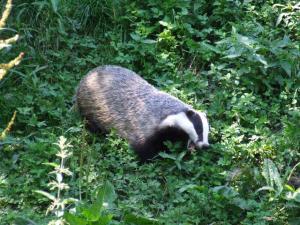
We have two active badger setts within the boundaries of the Attenborough Arboretum.
The followng video shows our badgers nocturnal activities in March of this year (2023). They emerge from the sett about 9:15 pm. After a brief exploration of the vicinity they set off on their nocturnal travels.
They return a few hours later, approaching 1:00 in the morning. After checking out the sett entrances area they then retire for the night.
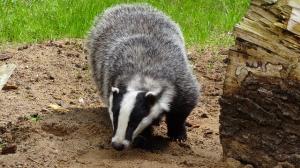
There are many different kinds of badger spread across the globe, but here in the UK we have only the European Badger.
The European badger is a strange looking creature with some habits in common with humans. For instance, they keep their setts meticulously clean and regularly change the 'bedding' of straw and grass. They also choose a partner and remain faithful to that partner for life.
With his striking markings and strange habits the shy badger is one of the oddest creatures to be found in Great Britain. Badgers are found in most of our counties, but are rarer in those areas which are prone to flooding, such as East Anglia.
From the tip of his snout to the tip of his tail a badger is about three feet long. The tail itself measures about four inches. Badgers usually weigh about twenty-five pounds, although a large one may reach up to forty pounds. Badgers are sturdy and strong, with powerful shoulders and claws for digging, and a powerful bite too.
The most striking thing about a badger is his markings. Most of the badger's head, including the tips of the ears, is white. Remarkably there are two thick black stripes running back from the snout and past the eyes and ears on each side of the head.
These markings make the badger easily recognisable, even at twilight, which is when badgers first become active.
Badgers are very powerful diggers and move huge amounts of earth when making their underground homes which we call setts. The have long stout claws which they often sharpen by scratching on nearby trees.
Badgers' setts are usually dug amongst trees where there is plenty of cover. Setts can be very big. The biggest ones may have as many as fifty entrances and stretch for over a hundred yards. At various places along the tunnels are sleeping and breeding chambers.
Living in such large setts can pose problems. One is that of ventilation. With many badgers sharing a sett the air may become stale and foul. To reduce this problem badgers dig level tunnels so that there are no lower levels where bad air can settle. They also make small air holes along the length of tunnels and these are hidden by twigs.
Another problem is sanitation and hygiene. Badgers have outside toilets and dig shallow dung pits close to their sett entrances. The chambers in their setts are lined with bedding, usually straw, grass or bracken. The badger brings it to it's sett by dragging a bundle backwards whilst holding it between the front paws and the chin.
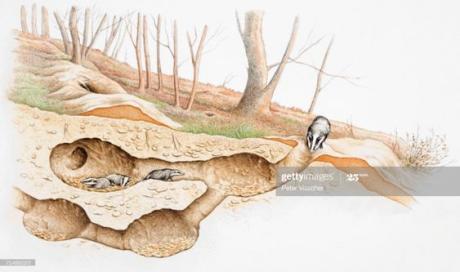
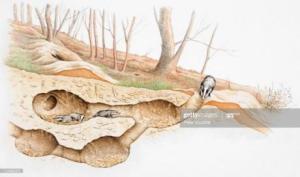
Although most of the bedding is brought in during the autumn months, badgers do change it regularly throughout the rest of the year. Badgers also tend to just use one part of the sett at a time. Badgers have quite poor eyesight and only notice something when it moves. However, they do have a strong sense of smell and very good hearing to compensate for this. Badgers can recognise eachother and other animals including humans using this keen sense of smell.
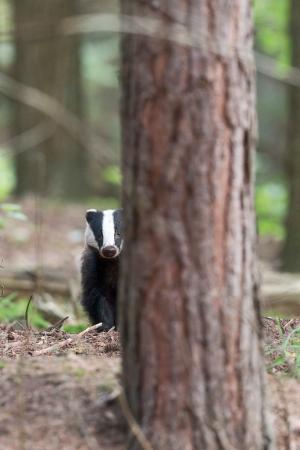
Diet
The European badger is omnivorous, meaning that it will eat both plants and animals. Badgers are nocturnal animals, feeding during the night and sleeping by day. In the autumn badgers eat a lot of fruit and seeds, including acorns, blackberries and apples. It is during this time they also dig up and eat the bulbs, roots and rhizomes of plants such as bluebells. In the spring, when the tree sap is rising, badgers have been known to strip the bark from sycamores and beeches in order to lick the sweet sappy wood underneath. They will also eat grass, leaves and fungi,
Probably the favourite food of the badger is the worm, of which it eats great quantities. One badger that was killed by a car was found to have over 300 worms in it's stomach. The also eat beetles and slugs and snails too. Wasp nests are a rare treat as they love to eat the fat grubs contained inside. Bee nests contain delicious honey! The stinging does not seem to affect the thick skinned badger. The European badger will also eat smaller animals. They eat plenty of rats, mice and voles. Badgers will also eat hedgehogs. They do this by turning the hedgehog onto it's back and prising the balled creature open and biting into the unprotected stomach.
Family Life
Badgers are family animals, with the same pair of badgers mating and producing young each year. It is possible to tell the male and females apart as the males, or boars, have a wider head and thicker neck than the females, or sows. The boar's tail is also lighter in colour than the sow's. Badgers mate between July and mid-September. During the mating season badgers often chase and fight eachother and rush around in a mad fashion.
The young are born in the February or March of the following year. This is the ideal time for birth, since it gives the cubs almost a whole year, through the summer months, to feed and grow, before having to face their first winter. In the winter badgers often stay underground for long periods resting and avoiding the cold and lack of ready food.
In January the badgers stay in their setts for most of the time. There is little food about and they live on the body fat that they have built up over the previous year. They will come out from time to time on warmer nights. They often take the opportunity to replace bedding during these excursions.
In February and March the cubs are born, usually there being two or three cubs in the litter. Their bodies are about 12 centimetres in length and the tails another 3 or 4 centimetres, and they only weigh about 3 ounces. Their fur is a dirty white and they do not possess the characteristic stripes on their heads as yet. During this time the sow suckles the young and the boar goes out to forage for food.
By the end of March the cubs are ready to leave the sett for the first time. From then until July the cubs grow to be almost as large as their parents. This is also a period of learning for the cubs. The mother will lead them out of the sett, and then cleans them and herself to get rid of bothersome parasites.
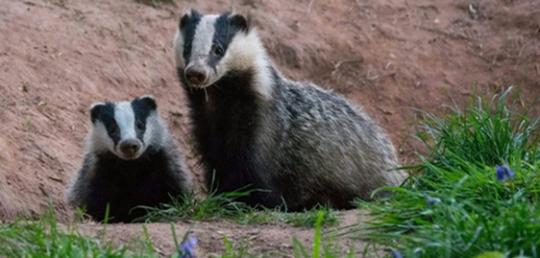
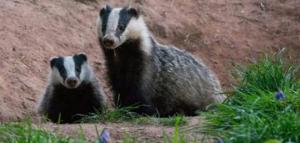
By May the cubs have become bolder and instead of staying close to the mother are now playing boisterously outside. When not play-fighting and chasing eachother, the mother teaches the cubs how to dig for food, and how to select and fetch bedding material for the sett. They also learn to use the dung pits located nearby.
The mating period is between July and mid-September when the pair of badgers will become more excitable and energetic than usual. They often go to favourite play areas in the locality and sometimes their romping flattens large areas of grass and plants. After they have mated, the pair and their cubs may leave the current sett and retire to another that they share with two or three other families. Before going they spend time cleaning out the old sett for their return in the autumn time.
By October the cubs usually leave the parents for good and set up on their own. The mated pair then start to prepare their old sett ready for the long cold winter months. On dry nights they will collect up bedding to line the chambers and will continue to do this until the end of November. The badgers do not play much by this time of the year, but still come out on most nights.
From November through January the weather is at it's worst. It is often said by people that badgers hibernate during this period, but true hibernation is only found in a few mammals. A hibernating mammal allows it's body temperature to drop to that of the surrounding air. It does this by slowing down the body's metabolism so that heartbeat and breathing become very slow and in this state the mammal goes into a very deep sleep.
This is how hedgehogs hibernate, but badgers do not hibernate. Although they become sluggish and may stay in their setts for up to 3 days at a time during the cold winter months, they are still active. You can often see fresh dung in the nearby dung pits and also tracks in the snow during this period. By mid-January the pair are preparing the sett for the arrival of the new litter.